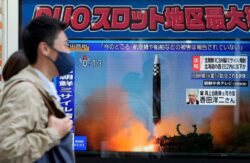Pedestrians walk past a street television showing news of North Korea firing a ballistic missile on a street in Tokyo, Japan (Picture: EPA)
North Korea has fired an intercontinental ballistic missile (ICBM) capable of striking anywhere in the US, according to the defence ministry in Japan.
The missile was fired from near the capital and flew across the country, landing just 130 miles west of Hokkaido inside Japan’s exclusive economic zone.
It comes a day after a smaller missile launch by the North amid a warning of ‘fiercer military responses’ to the US boosting its security presence in the region.
Japanese Defence Minister Yasukazu Hamada told reporters depending on the weight of the warhead, it had a range of over 9,320 miles, ‘in which case it could cover the entire mainland United States’.
The US quickly slammed the launch and vowed to take ‘all necessary measures’ to guarantee the safety of its mainland and allies South Korea and Japan.
Vice President Kamala Harris will separately meet with leaders of Japan, South Korea, Australia, New Zealand and Canada who are attending a regional forum in Bangkok to discuss North Korea’s recent ballistic missile launch.
North Korea launched what is believed to be an intercontinental ballistic missile (ICBM), which landed inside Japan’s exclusive economic zone (EEZ) (Picture: EPA)
Vice President Kamala Harris arrives to attend the 29th APEC Economic Leaders Meeting (AELM) in Bangkok, Thailand (Picture: Reuters)
This has become a record-breaking year for the nuclear-armed country’s missile programme, after it resumed testing ICBMs for the first time since 2017 and broke its self-imposed moratorium on long-range launches as denuclearisation talks stalled.
North Korea also launched an ICBM on November 3, but experts said that weapon failed to fly its intended flight and fell into the ocean after a stage separation.
That test was believed to have involved a developmental missile called Hwasong-17.
North Korea has two other types of ICBM — Hwasong-14 and Hwasong-15 — and their test-launches in 2017 proved they could potentially reach parts of the US homeland.
The Hwasong-17 has a longer potential range than the others, and its huge size suggests it’s designed to carry multiple nuclear warheads to defeat missile defence systems.
Photo distributed by the North Korean government shows what it says a test-fire of a Hwasong-17 intercontinental ballistic missile (ICBM) on March 24, 2022 (Picture: AP)
Hwasong-17 ICBMs displayed during a military parade to celebrate the 90th anniversary of the founding of the Korean People’s Revolutionary Army (Picture: AFP via Getty Images)
Some experts say the November 3 test showed some technological progress in the development of the Hwasong-17, given that in its earlier test in March, the missile exploded soon after lift-off.
It wasn’t immediately known if North Korea launched a Hwasong-17 missile again on Friday or something else.
In recent months, North Korea has performed dozens of shorter-range missile tests that it called simulations of nuclear attacks on South Korean and US targets.
But it had halted weapons launches for about a week before it fired a short-range ballistic missile on Thursday.
Before Thursday’s launch, the North’s foreign minister, Choe Son Hui, threatened to launch ‘fiercer’ military responses to the US bolstering its security commitment to its allies South Korea and Japan.
Choe was referring to President Joe Biden’s recent trilateral summit with Yoon and Japanese Prime Minister Fumio Kishida on the sidelines of a regional gathering in Cambodia.
People sit near a television showing a news broadcast with file footage of a North Korean missile test, at a railway station in Seoul (Picture: AFP via Getty Images)
In their joint statement, the three leaders strongly condemned North Korea’s recent missile tests and agreed to work together to strengthen deterrence.
Biden reaffirmed the US commitment to defend South Korea and Japan with a full range of capabilities, including its nuclear arms.
Choe didn’t say what steps North Korea could take but said that ‘the US will be well aware that it is gambling, for which it will certainly regret’.
Pyongyang sees the US military presence in the region as proof of its hostility toward North Korea.
It has said its recent series of weapons launches were its response to what it called provocative military drills between the United States and South Korea.
There have been concerns that North Korea might conduct its first nuclear test in five years as its next major step toward bolstering its military capability against the United States and its allies.
North Korea has been under multiple rounds of United Nations sanctions over its previous nuclear and missile tests.
But no fresh sanctions have been applied this year though it has conducted dozens of ballistic missile launches, which are banned by UN Security Council resolutions.
That’s possible because China and Russia, two of the UN council’s veto-wielding members, oppose new sanctions.
Washington is locked in a strategic competition with Beijing and in a confrontation with Moscow over its invasion of Ukraine.
Get in touch with our news team by emailing us at [email protected].
For more stories like this, check our news page.
It comes amid a warning from the North of ‘fiercer military responses’ to the US boosting its security presence in the region.





